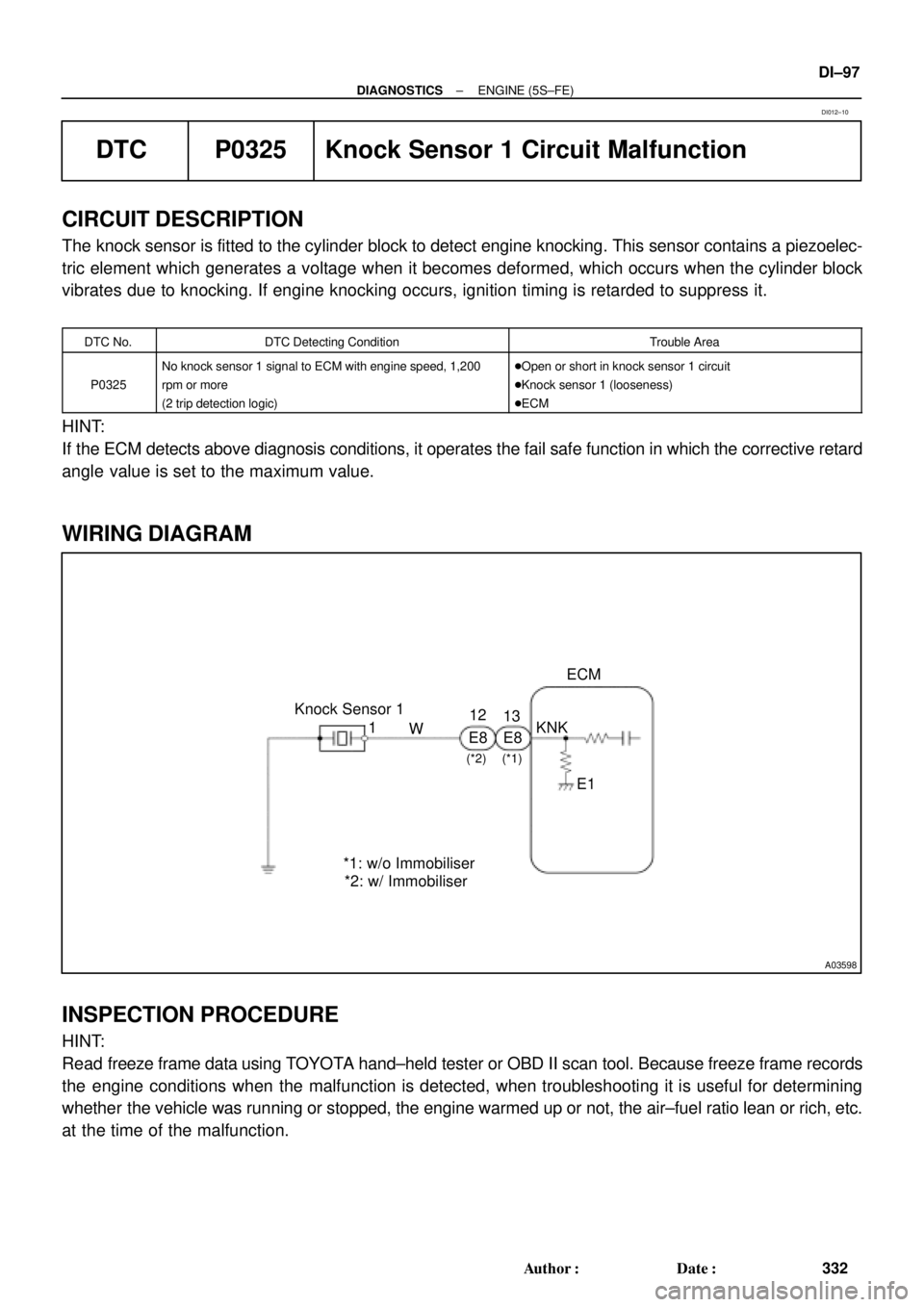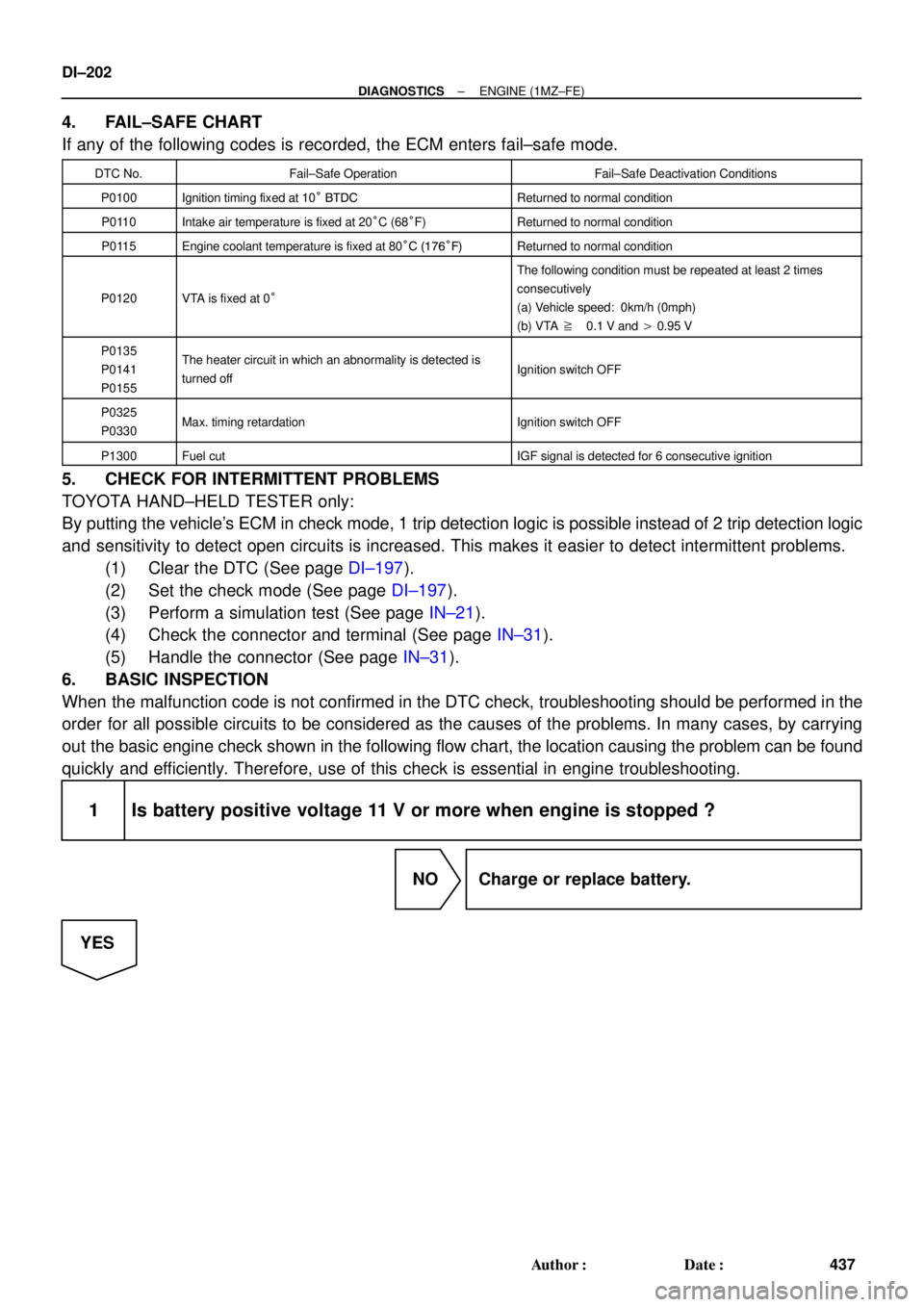Page 2437 of 4770

± DIAGNOSTICSENGINE (5S±FE)
DI±17
252 Author�: Date�:
DTC No.
(See Page)Detection ItemTrouble AreaMIL*1Memory
P0136
(DI±77)Heated Oxygen Sensor Circuit
Malfunction
(Bank 1 Sensor 2)
�Heated oxygen sensor��
P0141
(DI±75) Heated Oxygen Sensor Heater
Circuit Malfunction
(Bank 1 Sensor 2)
�Same as DTC P0135��
*3
P0171
(DI±84)
System too Lean
(Fuel Trim)
(Except California Spec.)
�Air intake (hose loose)
�Fuel line pressure
�Injector blockage
�Heated oxygen sensor (bank 1 sensor 1)
�Manifold absolute pressure sensor
�Engine coolant temp. sensor
�*1�
*3
P0172
(DI±84)
System too Rich
(Fuel Trim)
(Except California Spec.)
�Fuel line pressure
�Injector leak, blockage
�Heated oxygen sensor (bank 1 sensor 1)
�Manifold absolute pressure sensor
�Engine coolant temp. sensor
�*1�
*4
P0171
(DI±79)
System too Lean
(Fuel Trim)
(Only for California Spec.)
�Air intake (hose loose)
�Fuel line pressure
�Injector blockage
�Manifold absolute pressure sensor
�Engine coolant temp. sensor
�A/F sensor
�*1�
*4
P0172
(DI±79)
System too Rich
(Fuel Trim)
(Only for California Spec.)
�Fuel line pressure
�Injector leak, blockage
�Manifold absolute pressure sensor
�Engine coolant temp. sensor
�A/F sensor
�*1�
P0300
(DI±89)Random/Multiple Cylinder
Misfire Detected
�Ignition system
�Injector
�Fuel line pressure
�EGR
Ci
P0301
P0302
P0303
P0304
(DI±89)Misfire Detected
± Cylinder 1
± Cylinder 2
± Cylinder 3
± Cylinder 4
�Compression pressure
�Valve clearance not to specification
�Valve timing
�Manifold absolute pressure sensor
�Engine coolant temp. sensor
�Open or short engine wire
�Connector connection
�ECM�
�*2�
P0325
(DI±97)Knock Sensor 1 Circuit
Malfunction�Open or short in knock sensor 1 circuit
�Knock sensor 1 (looseness)
�ECM
�*1�
P0335
(DI±100)Crankshaft Position Sensor
ºAº Circuit Malfunction
�Open or short in crankshaft position sensor circuit
�Crankshaft position sensor
�Starter
�ECM
�*1�
*1: MIL lights up
*
2: MIL lights up or blinking
*
3: Except California Specification vehicles
*
4: Only for California Specification vehicles
Page 2509 of 4770

± DIAGNOSTICSENGINE (5S±FE)
DI±89
324 Author�: Date�:
DTC P0300 Random/Multiple Cylinder Misfire Detected
DTC P0301 Cylinder 1 Misfire Detected
DTC P0302 Cylinder 2 Misfire Detected
DTC P0303 Cylinder 3 Misfire Detected
DTC P0304 Cylinder 4 Misfire Detected
CIRCUIT DESCRIPTION
Misfire: The ECM uses the crankshaft position sensor and camshaft position sensor to monitor changes in
the crankshaft rotation for each cylinder.
The ECM counts the number of times the engine speed change rate indicates that misfire has occurred. And
when the misfire rate equals or exceeds the count indicating that the engine condition has deteriorated, the
MIL lights up.
If the misfire rate is high enough and the driving conditions will cause catalyst overheating, the MIL blinks
when misfiring occurs.
DTC No.DTC Detecting ConditionTrouble Area
P0300Mi fi i f d li d i d t t d d i ti l
�Ignition system
�Injector
�Fuel line pressure
�EGR
P0300
P0301
P0302
P0303
P0304
Misfiring of random cylinders is detected during any particular
200 or 1,000 revolutions
For any particular 200 revolutions for engine, misfiring is de-
tected which can cause catalyst overheating
(This causes MIL to blink)
�EGR
�Compression pressure
�Valve clearance not to specification
�Valve timing
�Manifold absolute pressure sensor
P0304(This causes MIL to blink)�Manifold absolute ressure sensor
�Engine coolant temp. sensor
�Open or short in engine wire
�Connector connection
�ECM
HINT:
When the 2 or more codes for a misfiring cylinder are recorded repeatedly but no random misfire code is
recorded, it indicates that the misfires were detected and recorded at different times.
DI011±07
Page 2516 of 4770
DI±96
± DIAGNOSTICSENGINE (5S±FE)
331 Author�: Date�:
8 Check manifold absolute pressure sensor and engine coolant temp. sensor
(See pages SF±53 AND SF±49).
NG Repair or replace.
OK
Check compression pressure, valve
clearance and valve timing
(See pages EM±3, EM±4 AND EM±23).
Page 2517 of 4770

A03598
Knock Sensor 1ECM
KNK
E1 E8 13
W 1
*1: w/o Immobiliser
*2: w/ Immobiliser
(*1) (*2)
E812
± DIAGNOSTICSENGINE (5S±FE)
DI±97
332 Author�: Date�:
DTC P0325 Knock Sensor 1 Circuit Malfunction
CIRCUIT DESCRIPTION
The knock sensor is fitted to the cylinder block to detect engine knocking. This sensor contains a piezoelec-
tric element which generates a voltage when it becomes deformed, which occurs when the cylinder block
vibrates due to knocking. If engine knocking occurs, ignition timing is retarded to suppress it.
DTC No.DTC Detecting ConditionTrouble Area
P0325
No knock sensor 1 signal to ECM with engine speed, 1,200
rpm or more
(2 trip detection logic)�Open or short in knock sensor 1 circuit
�Knock sensor 1 (looseness)
�ECM
HINT:
If the ECM detects above diagnosis conditions, it operates the fail safe function in which the corrective retard
angle value is set to the maximum value.
WIRING DIAGRAM
INSPECTION PROCEDURE
HINT:
Read freeze frame data using TOYOTA hand±held tester or OBD II scan tool. Because freeze frame records
the engine conditions when the malfunction is detected, when troubleshooting it is useful for determining
whether the vehicle was running or stopped, the engine warmed up or not, the air±fuel ratio lean or rich, etc.
at the time of the malfunction.
DI012±10
Page 2522 of 4770
DI±102
± DIAGNOSTICSENGINE (5S±FE)
337 Author�: Date�:
3 Inspect sensor installation and teeth of crankshaft timing pulley
(See pages IG±10 and EM±15).
NG Tighten the sensor. Replace crankshaft timing
pulley.
OK
Check and replace ECM (See page IN±31).
Page 2524 of 4770

DI±104
± DIAGNOSTICSENGINE (5S±FE)
339 Author�: Date�:
INSPECTION PROCEDURE
HINT:
Read freeze frame data using TOYOTA hand±held tester or OBD II scan tool. Because freeze frame records
the engine conditions when the malfunction is detected, when troubleshooting it is useful for determining
whether the vehicle was running or stopped, the engine warmed up or not, the air±fuel ratio lean or rich, etc.
at the time of the malfunction.
1 Check resistance of camshaft position sensor (signal generator)
(See page IG±1).
Reference: INSPECTION USING OSCILLOSCOPE
Refer to DTC P0335 (Crankshaft Position Sensor ºAº Circuit Malfunction) on page DI±100.
NG Replace camshaft position sensor.
OK
2 Check for open and short in harness and connector between ECM and camshaft
position sensor (See page IN±31).
NG Repair or replace harness or connector.
OK
3 Inspect sensor installation and tooth of camshaft timing pulley
(See pages IG±9 and EM±17).
NG Tighten the sensor. Replace camshaft timing
pulley.
OK
Check and replace ECM (See page IN±31).
Page 2583 of 4770

± DIAGNOSTICSENGINE (5S±FE)
DI±163
398 Author�: Date�:
DTC P1300 Igniter Circuit Malfunction No.1
DTC P1310 Igniter Circuit Malfunction No.2
CIRCUIT DESCRIPTION
The ECM determines the ignition timing, turns on Tr1 at a predetermined angle (°CA) before the desired
ignition timing and outputs and ignition signal (IGT) 1 to the igniter.
Since the width of the IGT signal is constant, the dwell angle control circuit in the igniter determines the time
the control circuit starts primary current flow to the ignition coil based on the engine rpm and ignition timing
one revolution ago, that is, the time the Tr2 turns on.
When it reaches the ignition timing, the ECM turns Tr1 off and outputs the IGT signal O.
This turns Tr2 off, interrupting the primary current flow and generating a high voltage in the secondary coil
which causes the spark plug to spark. Also, by the counter electromotive force generated when the primary
current is interrupted, the igniter sends an ignition confirmation signal (IGF) to the ECM. The ECM stops fuel
injection as a fail safe function when the IGF signal is not input to the ECM.
DTC No.DTC Detecting ConditionTrouble Area
P1300No IGF signal to ECM for 4 consecutive IGT1 signals during
engine running�Open or short in IGF or IGT circuit from igniter to ECM
�Ignition coil No.1 (Igniter No.1)
�ECM
P1310No IGF signal to ECM for 4 consecutive IGT2 signals during
engine running�Open or short in IGF or IGT circuit from igniter to ECM
�Ignition coil No.2 (Igniter No.2)
�ECM
HINT:
Ignition coil No.1 is for cylinder No.1 and No.4, and ignition coil No.2 is for cylinder No.2 and No.3.
DI01G±06
Page 2622 of 4770

DI±202
± DIAGNOSTICSENGINE (1MZ±FE)
437 Author�: Date�:
4. FAIL±SAFE CHART
If any of the following codes is recorded, the ECM enters fail±safe mode.
DTC No.Fail±Safe OperationFail±Safe Deactivation Conditions
P0100Ignition timing fixed at 10° BTDCReturned to normal condition
P0110Intake air temperature is fixed at 20°C (68°F)Returned to normal condition
P0115Engine coolant temperature is fixed at 80°C (176°F)Returned to normal condition
P0120VTA is fixed at 0°
The following condition must be repeated at least 2 times
consecutively
(a) Vehicle speed: 0km/h (0mph)
(b) VTA ��0.1 V and � 0.95 V
P0135
P0141
P0155The heater circuit in which an abnormality is detected is
turned offIgnition switch OFF
P0325
P0330Max. timing retardationIgnition switch OFF
P1300Fuel cutIGF signal is detected for 6 consecutive ignition
5. CHECK FOR INTERMITTENT PROBLEMS
TOYOTA HAND±HELD TESTER only:
By putting the vehicle's ECM in check mode, 1 trip detection logic is possible instead of 2 trip detection logic
and sensitivity to detect open circuits is increased. This makes it easier to detect intermittent problems.
(1) Clear the DTC (See page DI±197).
(2) Set the check mode (See page DI±197).
(3) Perform a simulation test (See page IN±21).
(4) Check the connector and terminal (See page IN±31).
(5) Handle the connector (See page IN±31).
6. BASIC INSPECTION
When the malfunction code is not confirmed in the DTC check, troubleshooting should be performed in the
order for all possible circuits to be considered as the causes of the problems. In many cases, by carrying
out the basic engine check shown in the following flow chart, the location causing the problem can be found
quickly and efficiently. Therefore, use of this check is essential in engine troubleshooting.
1 Is battery positive voltage 11 V or more when engine is stopped ?
NO Charge or replace battery.
YES